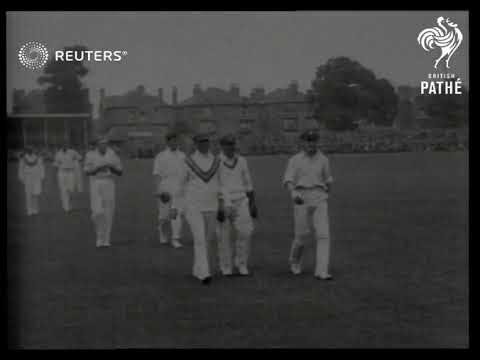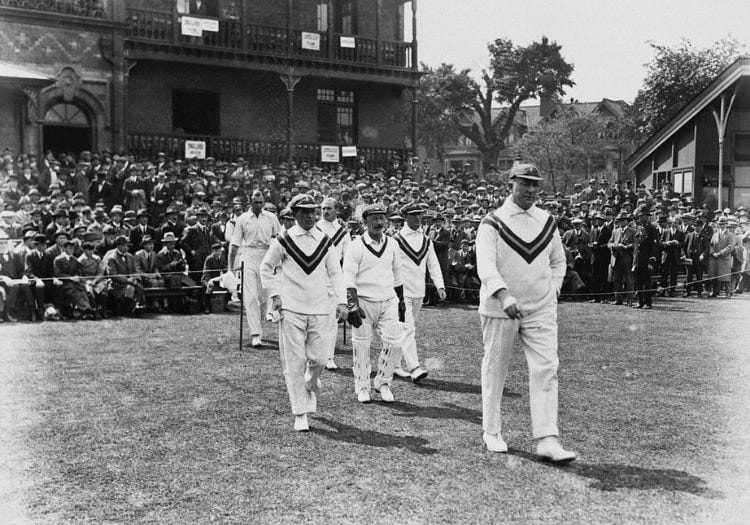The First Centenary Test: Part I
Jim Ledbetter on the build-up to the First Test of the 1921 Ashes
Although not attracting the publicity of the ‘Centenary’ Test, played at Melbourne in March 1977, which commemorated the 100th anniversary of the First Test played between England and Australia on the same ground, the 100th encounter between England and Australia in May 1921 at Trent Bridge, Nottingham was recognised at the time as an important landmark in the history of Anglo-Australia Tests. Pelham Warner commented in his new publication The Cricketer that “May 28, 1921 will ever remain a memorable date in the history of cricket.” The local Nottingham newspapers were also aware of the special significance of the match, the Nottingham Guardian observing that there was surprise and disappointment in some quarters that such an important game had not been staged at either Lord’s or The Oval. Interest in this particular Test was further stimulated by a statistical quirk which for some observers, the Nottingham Observer suggested, made this meeting of the two sides a “kind of decider.” The reason behind this thinking was a simple one. Of the previous 99 Anglo-Australian Tests played, each team had 40 wins to its credit. For the first time since 1886, the Australians had the opportunity to forge ahead of their rivals, if current form was taken into account.
Only a few months earlier Australia had cruised to an unprecedented ‘whitewash’ in the five-match series in Australia and no less than 12 of the 15-strong Australian touring party had participated in that series. Yet if the visitors were clearly seen as the favourites to win the 1921 series in England, home supporters could and did take some comfort from their side’s home record of 17 victories to Australia’s eight and a nine to four ratio in taking the series in England. Despite the magnitude of the Australian victory in 1920/21, there were still reservations about their ability prior to the start of the tour. The Australian manager, Sidney Smith, commented that “many of the English newspapers were of the opinion that our team would not compare with previous Australian combinations and that we would not win the Tests.” The Times went so far as to claim that the Australian bowling was weaker than that of any Australian side.
An examination of the Australian touring party suggests that this observation was not quite as absurd as it subsequently came to appear. Certainly it was acknowledged that two of the Australian bowlers were potential matchwinners at Test level. Jack Gregory, described in Wisden in 1920, after his performances with the AIF, as being “very fast indeed,” had lived up to this reputation with 23 wickets in his first series against England. A fellow Test debutant, the leg-break and googly bowler, Arthur Mailey, had done even better with a record 36 wickets in his five Test appearances.
However, questions could legitimately be raised about the quality of the remainder of the Australian attack. McDonald, the other quick bowler, had still to prove himself at Test level, have achieved little of note of his three Test appearances. Armstrong, the captain, had been a force in Test cricket, but at 42 years of age and carrying a weight of 20 stone, his role as a major contributor to the Australian attack was a questionable one. The success of Gregory and Mailey had also provided few opportunities for the remaining bowlers, Ryder, Collins and Macartney, whilst Hendry and Andrews were unknown quantities at Test level.
Collins and Gregory had graduated to the full Australian side after appearing for the Australian Imperial Forces (AIF) side which had toured England in 1919, followed by a tour of South Africa and representative games in Australia, as had Pellew, Oldfield and Taylor. They were also joined by a number of other debutants in the series against England in 1920/21, Mailey, Ryder and McDonald. These eight players, alongside previous tourists, Armstrong, Bardsley, Carter, Macartney and Mayne, plus two uncapped newcomers in Hendry and Andrews, made up the 15-strong touring party.
English opinions were quickly revised before the First Test. Ominously Gregory took a wicket with the first ball of the tour against Leicestershire, whilst his opening partner, McDonald, took 8/41 in the same fixture. With Mailey and Armstrong also amongst the wickets and most of the recognised batsmen making runs, the press now began to describe to tourists as “probably the strongest side to visit England.” Arriving at Nottingham with no injury problems, the Australians were able to field their strongest XI, omitting Oldfield, Ryder and Mayne from their chosen Test XII.
As it became apparent during May that the Australian victory in 1920/21 was no fluke, the England Selectors, H.K. Foster, R.H. Spooner and J. Daniell, whose choice met with “universal approval” according to The Cricketer, were bombarded with advice on the choice of a side capable of beating the Australians. A.C. MacLaren, a former England captain, urged the selectors to “tear up the book of form and throw out those whose only crime is increasing age.” The Times warned that “batsmen will have to be chosen with special regard to their ability to play very fast bowling, other considerations being quite secondary.” Both George Gunn, considered by many observers to be the best player of fast bowling after Hobbs, and C.B. Fry were mentioned in this context.
Hobbs, an automatic choice, was unavailable for the Trent Bridge Test. It was ironic that he should sustain an injury against the tourists, having played a glorious innings of 85 against them. Another automatic choice, J.W. Hearne, also could not be considered, still recovering from the illness which had laid him low in Australia. Fry, although 49 years of age, and having played very little cricket in the past two seasons, was also being supported in several newspapers as a replacement for the incumbent captain, Douglas. It was, commented the Nottingham Journal indignantly, “another London press stunt,” aimed at excluding John Douglas, “the man of the set jaw and iron nerves.”
Another problem facing the selectors was the shortness of time between the series just completed in Australian and the opening Test in 1921. The team which had fared so poorly in Australian in 1920/21 had been considered the best available at that time, apart from the debatable omission of Percy Holmes. After five consecutive, decisive defeats, there was clearly a need for new faces in the England XI, yet there was little time in the new season to unearth new talent. Complaints in The Cricketer about the lack of any kind of a trial match or the too early date of the First Test, which incidentally was being staged at approximately the same time as in previous tours, had come a little too late in the day for anything to be done about them. Whether the same points would have been raised had England returned home from Australia victorious is another matter.
Perhaps through sympathy with the predicament of the Selectors, the criticism of the chosen England XI was muted. Col.Philip Trevor wrote in the Daily Telegraph that “If we are beaten we must not lay them blame for our defeat upon our Selection Committee.” Warner was more optimistic, writing in The Cricketer that “they (The Selectors) have done their work very well indeed and have chosen the best possible side in the circumstances…. We believe that this XI will give a good account of itself.” It was a view supported by the three Nottingham local papers, the Evening Post commenting that the team “met with almost universal approval,” and was a “workmanlike combination” which showed distinct promise of proving capable of accounting for the Australians.
It was a safe side, containing no surprises. Six players from the beaten touring side were chosen, Douglas as captain, Woolley, Hendren, Strudwick, Rhodes and Howell. The remaining five were all making their debut in Test cricket, although two of them, Knight and Jupp had declined invitations to tour Australia in 1920/21. Holmes, the Yorkshire opening batsman, had also been considered unfortunate to have been omitted from the touring party. The two remaining selections were the Lancashire batsman, Ernest Tyldesley and Richmond, the Nottinghamshire leg-break bowler, both of whom had also been in contention for the winter tour to Australia. J.W.H. Makepeace, who had played in four Tests on the winter tour, was made 12th man.
All were in good form, none more so than Douglas, who in his previous game for Essex against Derbyshire, had scored an unbeaten 210 and taken 9/47. Howell was also given his opportunity ahead of rivals Durston and Louden, who had both done well against the tourists, on the grounds of both current form and that he had been the victim of indifferent fielding in Australia.
Neither Fry nor Gunn, whose selection had been supported in many quarters, were to be chosen for either the First Test or any subsequent one in the series. Fry, significantly chosen to captain the MCC against the Australians, was forced to withdraw through injury, thus putting him out of contention. Gunn, who had struck 131 against the AIF in 1919, and according to Wisden had not been “troubled at all by Gregory’s great pace,” was experiencing an indifferent season, having reached a top-score of only 38 in his eight innings. Even the local press, his staunchest supporters, were forced to admit that “so far, the younger Gunn has not found his true form.”
If there was general support for the chosen side, there were few illusions about the task facing it. “Never,” commented The Times, “has England started a Test series at home with the odds so much against us.” The Daily Telegraph echoed these sentiments, declaring that the Trent Bridge XI appeared to be no better than the side beaten in Australia. It accepted that the Australian side had no obvious weaknesses and that they possessed “two fast bowlers, each of whom is … better than any fast bowlers we have in this country.” Deprived of Hobbs and Hearne, with five debutants, the highest number to appear in an England side in England since the inaugural Test in 1880, and only one player, Knight, under the age of 30, facing a team which a few months earlier had completed its fifth consecutive victory against an England side, it is difficult to argue with these sentiments.
Even the advantage of Test experience in England lay with the visitors. There can be few occasions when the visiting side contained more players with Test experience in England than the home side. Armstrong, Bardsley, Macartney and Carter had all played in the 1909 series, Armstrong in 1905 and Bardsley and Macartney in 1912. Only three Englishmen, Douglas, Rhodes and Woolley had done so. Even in terms of experience, the visitors appeared to have the edge.
This article first appeared in The Cricket Statistician for Winter 1997. To join the Association of Cricket Statisticians and Historians, and subscribe to the journal, please visit our website:




